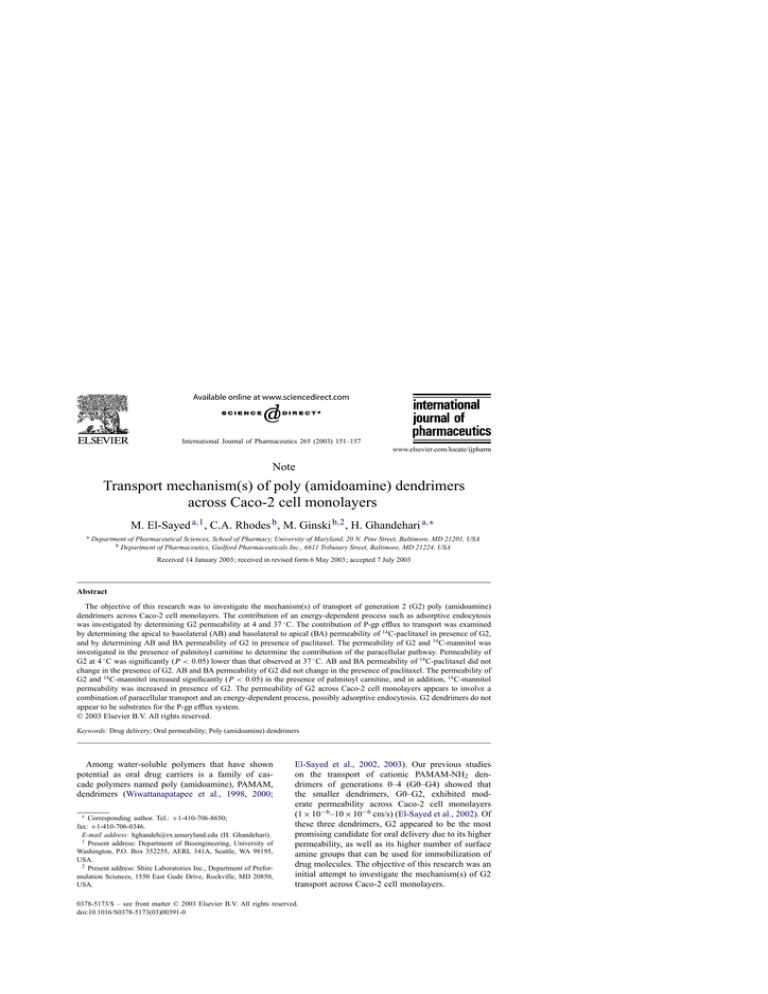
International Journal of Pharmaceutics 265 (2003) 151–157
Note
Transport mechanism(s) of poly (amidoamine) dendrimers
across Caco-2 cell monolayers
M. El-Sayed a,1 , C.A. Rhodes b , M. Ginski b,2 , H. Ghandehari a,∗
a
Department of Pharmaceutical Sciences, School of Pharmacy, University of Maryland, 20 N. Pine Street, Baltimore, MD 21201, USA
b Department of Pharmaceutics, Guilford Pharmaceuticals Inc., 6611 Tributary Street, Baltimore, MD 21224, USA
Received 14 January 2003; received in revised form 6 May 2003; accepted 7 July 2003
Abstract
The objective of this research was to investigate the mechanism(s) of transport of generation 2 (G2) poly (amidoamine)
dendrimers across Caco-2 cell monolayers. The contribution of an energy-dependent process such as adsorptive endocytosis
was investigated by determining G2 permeability at 4 and 37 ◦ C. The contribution of P-gp efflux to transport was examined
by determining the apical to basolateral (AB) and basolateral to apical (BA) permeability of 14 C-paclitaxel in presence of G2,
and by determining AB and BA permeability of G2 in presence of paclitaxel. The permeability of G2 and 14 C-mannitol was
investigated in the presence of palmitoyl carnitine to determine the contribution of the paracellular pathway. Permeability of
G2 at 4 ◦ C was significantly (P < 0.05) lower than that observed at 37 ◦ C. AB and BA permeability of 14 C-paclitaxel did not
change in the presence of G2. AB and BA permeability of G2 did not change in the presence of paclitaxel. The permeability of
G2 and 14 C-mannitol increased significantly (P < 0.05) in the presence of palmitoyl carnitine, and in addition, 14 C-mannitol
permeability was increased in presence of G2. The permeability of G2 across Caco-2 cell monolayers appears to involve a
combination of paracellular transport and an energy-dependent process, possibly adsorptive endocytosis. G2 dendrimers do not
appear to be substrates for the P-gp efflux system.
© 2003 Elsevier B.V. All rights reserved.
Keywords: Drug delivery; Oral permeability; Poly (amidoamine) dendrimers
Among water-soluble polymers that have shown
potential as oral drug carriers is a family of cascade polymers named poly (amidoamine), PAMAM,
dendrimers (Wiwattanapatapee et al., 1998, 2000;
∗ Corresponding author. Tel.: +1-410-706-8650;
fax: +1-410-706-0346.
E-mail address: hghandeh@rx.umaryland.edu (H. Ghandehari).
1 Present address: Department of Bioengineering, University of
Washington, P.O. Box 352255, AERL 341A, Seattle, WA 98195,
USA.
2 Present address: Shire Laboratories Inc., Department of Preformulation Sciences, 1550 East Gude Drive, Rockville, MD 20850,
USA.
El-Sayed et al., 2002, 2003). Our previous studies
on the transport of cationic PAMAM-NH2 dendrimers of generations 0–4 (G0–G4) showed that
the smaller dendrimers, G0–G2, exhibited moderate permeability across Caco-2 cell monolayers
(1 × 10−6 –10 × 10−6 cm/s) (El-Sayed et al., 2002). Of
these three dendrimers, G2 appeared to be the most
promising candidate for oral delivery due to its higher
permeability, as well as its higher number of surface
amine groups that can be used for immobilization of
drug molecules. The objective of this research was an
initial attempt to investigate the mechanism(s) of G2
transport across Caco-2 cell monolayers.
0378-5173/$ – see front matter © 2003 Elsevier B.V. All rights reserved.
doi:10.1016/S0378-5173(03)00391-0
152
M. El-Sayed et al. / International Journal of Pharmaceutics 265 (2003) 151–157
PAMAM-NH2 (G2) (Sigma-Aldrich Co., St. Louis,
MO) was labeled using fluorescein isothiocyanate
(FITC, Sigma-Aldrich Co., St. Louis, MO) following
a previously reported method (El-Sayed et al., 2002).
Caco-2 cell monolayers were prepared by standard
procedures described previously and used for transport experiments 21–28 days after seeding (El-Sayed
et al., 2002).
Permeability of FITC-labeled G2 across Caco-2
cell monolayers was investigated in triplicate at a
donor concentration of 10.0 mM at pH 7.0, 37 ◦ C,
5% CO2 , 95% relative humidity, and shaking at 50
revolutions per minute (RPM) while maintaining sink
conditions. The contribution of adsorptive endocytosis was investigated by determining G2 permeability
at a lower temperature of 4 ◦ C. The permeability of
14 C-mannitol as control was not affected by temperature. It is assumed that the lower temperature will
reduce the contribution of energy-dependent mechanisms such as adsorptive endocytosis. Contribution of
the P-gp efflux system to G2 transport was also examined by determining the AB and BA permeability
of 14 C-paclitaxel at a donor concentration of 200 nM
(American Radiolabeled Chemicals, Inc., St. Louis,
MO) in presence of G2 (10.0 mM) and by determining
AB and BA permeability of G2 (10.0 mM) in presence
of paclitaxel (200 nM) under similar experimental
conditions.
The permeability of G2 and 14 C-mannitol was
investigated in the presence of palmitoyl carnitine
(0.3 mM) to determine the contribution of the paracellular pathway to G2 transport (Knipp et al., 1997).
Permeability samples were collected from the receiver
compartment at 30, 90, and 150 min. The 30-min
sample was discarded to ensure steady state transport
and sink conditions were maintained throughout the
experiments. G2 permeability samples were analyzed
using an HPLC system (Hewlett Packard, Palo Alto,
CA) with fluorescence detection (Shimadzu Corporation, Kyoto, Japan) following a method reported
earlier (El-Sayed et al., 2002). Permeability samples
of radioactive nuclides were analyzed by liquid scintillation counting (Beckman Coulter, Fullerton, CA).
The permeability of Caco-2 cell monolayers (Pm ) of
G2 and various radioactive nuclides was determined
following an equation reported earlier (El-Sayed et al.,
2002). t-test (Excel® ) was used to establish statistical
significance between different groups (P < 0.05).
AB permeability of G2 (10.0 mM), across Caco-2
cell monolayers, was investigated at 90 and 150 min
at both 37 and 4 ◦ C (Fig. 1). Permeability of G2 at
37 ◦ C increased with the increase in incubation time
that is similar to the trend reported earlier (El-Sayed
et al., 2002). Permeability of G2 at 4 ◦ C was significantly lower (P < 0.05) than that observed at
37 ◦ C at both incubation times of 90 and 150 min.
The observed decrease in G2 permeability at 4 ◦ C
in comparison to that observed at 37 ◦ C suggests
the contribution of adsorptive endocytosis to G2
transport across Caco-2 cell monolayers. It must
be noted however, that this observation is suggestive since temperature changes may also result in
changes in the diffusivity of the probes, membrane
fluidity, transporter activity, intracellular trafficking
and other factors that may contribute to changes in
permeability.
The permeability of 14 C-paclitaxel, a well-known
P-gp substrate, across Caco-2 cell monolayers was determined in both AB and BA directions in the presence
of G2 (10.0 mM) at incubation times 90 and 150 min.
Results at both time points were similar, therefore,
only the results at the last time point (150 min) are reported (Fig. 2). In the control experiment, BA permeability of 14 C-paclitaxel was four-fold higher than the
corresponding AB permeability demonstrating a functioning P-gp efflux system in the Caco-2 cell monolayers used in this study (Fig. 2A). Results indicate
that AB and BA permeability of 14 C-paclitaxel did not
change in the presence of G2 (10.0 mM) (P < 0.05)
(Fig. 2A).
The BA permeability of G2 (10.0 mM) was higher
than the corresponding AB permeability (Fig. 2B)
and is similar to the profile reported earlier (El-Sayed
et al., 2002). This suggested the contribution of possibly one or more of the efflux systems located at
the apical surface of Caco-2 cells, such as P-gp and
ABC transporters, to the observed G2 permeability
profile. This prompted us to examine the potential
contribution of P-gp efflux system on the directional
permeability of these cationic dendrimers. Both AB
and BA permeability of G2 did not change in the
presence of paclitaxel (200 nM) suggesting that G2
permeability does not involve the P-gp efflux system.
The observed directional permeability of G2 appears
to be due to the reported differences in the structure of the tight junctions of Caco-2 cell monolayers
M. El-Sayed et al. / International Journal of Pharmaceutics 265 (2003) 151–157
153
6
4.21
Permeability x 10 6 (cm/sec)
5
4
3
2.37
2
1
*
*
0.16
0.11
0
90 min
150 min
Fig. 1. AB permeability of G2 across Caco-2 cell monolayers at incubation times of 90 and 150 min at 37 ◦ C (䊐) and 4 ◦ C (䊏). Statistical
difference at P < 0.05 is denoted by ∗. Results are reported as mean ± standard error of the mean.
where tight junctional proteins are present only at the
apical but not at the basolateral membrane (Noach
et al., 1993). However, it must be noted that since
G2 at 10 mM causes the opening of tight junctions,
this may result in a change in the activity of the
cells with respect to efflux transport mechanisms.
Moreover, transporters other than P-gp can potentially be involved in PAMAM efflux. Therefore, the
contribution of efflux systems cannot be completely
ruled out at this time and further experiments are
needed.
The AB permeability of G2 increased significantly (P < 0.05) from 3.21 × 10−6 cm/s to
30.71 × 10−6 cm/s in the presence of palmitoyl carnitine at an incubation time point of 150 min (Fig. 3).
Under similar experimental conditions, palmitoyl
carnitine also caused a statistically significant (P <
0.05) increase in 14 C-mannitol AB permeability from
1.09 × 10−6 cm/s to 35.43 × 10−6 cm/s (Fig. 3). The
increase in G2 and 14 C-mannitol AB permeability
values was similar in the presence of palmitoyl carnitine suggesting the involvement of the paracellular
pathway to G2 transport across Caco-2 cell mono-
layers. This conclusion is further supported by the
observed incubation time-dependent decline in TEER
values (Fig. 4A) and the corresponding increase in
14 C-mannitol permeability (Fig. 4B) upon apical
and basolateral incubation of G2 (10.0 mM) with
Caco-2 cell monolayers. These results suggest that G2
modulates the tight junctions of Caco-2 cell monolayers, thus causing an increase in the paracellular
permeability.
Based on the macromolecular nature of PAMAM
dendrimers in general, and the compact spherical
geometry, hydrophilicity and positive charge of G2
in particular, we hypothesized that transport of G2
across Caco-2 cell monolayers may be attributed to
a combination of transcellular transport by adsorptive
endocytosis and paracellular transport via the tight
junctions. G2 exhibited lower permeability at 4 ◦ C
compared to its permeability at 37 ◦ C at a given incubation time point suggesting it could be transported
in part by adsorptive endocytosis. It is important to
note that reduced permeability at lower temperature
can also be attributed to inhibition of carrier-mediated
transport mechanisms, however the transport of G2
154
M. El-Sayed et al. / International Journal of Pharmaceutics 265 (2003) 151–157
12
10.32
10
Permeability x 10 6 (cm/sec)
8.20
8
6
3.22
4
2.01
2
(A)
0
AB
BA
14
10.94
11.15
12
Permeability x 10 6 (cm/sec)
10
8
6
3.21
2.94
4
2
(B)
0
AB
BA
Fig. 2. (A) AB and BA permeability of 14 C-paclitaxel across Caco-2 cell monolayers in absence (䊐) and presence (䊏) of G2 (10.0 mM)
at incubation time of 150 min. (B) AB and BA permeability of G2 (10.0 mM) across Caco-2 cell monolayers in absence (䊐) and presence
(䊏) of paclitaxel (200 nM) at incubation time of 150 min. Results are reported as mean ± standard error of the mean.
M. El-Sayed et al. / International Journal of Pharmaceutics 265 (2003) 151–157
155
45
35.43
40
35
Permeability x 10 6 (cm/sec)
30.71
30
25
20
15
10
3.21
5
1.00
0
G2
Mannitol
Fig. 3. AB permeability of G2 and 14 C-mannitol across Caco-2 cell monolayers in absence (䊐) and presence (䊏) of 0.3 mM palmitoyl
carnitine. Results are reported as mean ± standard error of the mean.
is unlikely to involve such systems due to their large
macromolecular nature and lack of structural similarity to the established substrates for such carrier
systems.
Our previous studies showed that the BA permeability of G2 was higher than the corresponding AB
permeability under the same experimental conditions
(El-Sayed et al., 2002) which suggested the contribution of an efflux system. Based on the results of this
study, it appears that the observed directional permeability of G2 is due to the differences in the structure of the tight junctions of Caco-2 cell monolayers
where tight junctional proteins are present at the apical but not at the basolateral membranes (Noach et al.,
1993).
The hydrophilic and cationic nature of G2 (resulting in modulation of the tight junctions) coupled
with its compact spherical geometry in solution suggest that G2 may also permeate across Caco-2 cell
monolayers via the paracellular route. Application
of permeation enhancers such as palmitoyl carnitine
has been shown to increase Caco-2 permeability for
molecules that are transported via the paracellular
route by dilation of the paracellular space (Knipp
et al., 1997). Our results show that palmitoyl carnitine caused an increase in AB permeability of
G2 that was similar to the observed increase in
14 C-mannitol permeability, a known paracellular permeability marker (Fig. 3). This suggests that G2 is in
part transported via the paracellular route. This observation is further supported by the time-dependent
decline in TEER and the corresponding increase
in permeability of 14 C-mannitol across Caco-2 cell
monolayers upon incubation with G2 (10.0 mM)
(Fig. 4).
In conclusion, our initial observations suggest that
the permeability of G2 across Caco-2 cell monolayers
occurs by a combination of paracellular transport and
an energy-dependent process such as adsorptive endocytosis. In addition, G2 dendrimers do not appear
to be substrates for the P-gp efflux system. While
these observations elucidate potential mechanisms
of PAMAM transport across intestinal epithelial barriers, additional studies allowing the quantification
and visualization of paracellular and transcellular
components are needed to further clarify the mechanisms of transport of these macromolecular drug
carriers.
156
M. El-Sayed et al. / International Journal of Pharmaceutics 265 (2003) 151–157
120
100
% Decline in TEER
80
60
40
20
(A)
0
0
30
60
90
120
150
Time (min)
30
Permeability x 10 6 (cm/sec)
25
20
15
10
5
(B)
0
30
60
90
120
150
Time (min)
Fig. 4. Effect of apical (䉬) and basolateral (䊏) incubation of G2 on: (A) transepithelial electrical resistance (TEER) and (B)
permeability across Caco-2 cell monolayers. Results are reported as mean ± standard error of the mean.
14 C-mannitol
M. El-Sayed et al. / International Journal of Pharmaceutics 265 (2003) 151–157
References
El-Sayed, M., Ginski, M., Rhodes, C.A., Ghandehari, H., 2002.
Transepithelial transport of poly (amidoamine) dendrimers across Caco-2 cell monolayers. J. Control. Release 81, 355–365.
El-Sayed, M., Ginski, M., Rhodes, C.A., Ghandehari, H.,
2003. Influence of surface chemistry of poly (amidoamine)
dendrimers on Caco-2 cell monolayers. J. Bioactive Compatible
Polym. 18, 93–111.
Knipp, G.T., Ho, N.F.H., Barsuhn, C.L., Borchardt, R.R., 1997.
Paracellular diffusion in Caco-2 cell monolayers: effect of
perturbation on the transport of hydrophilic compounds that
vary in charge and size. J. Pharm. Sci. 86, 1105–1110.
157
Noach, A.B.J., Kurosaki, Y., Blom-Roosemalen, M.C.M., de
Boer, A.G., Breimer, D.D., 1993. Cell-polarity dependent
effect of chelation on the paracellular permeability of
confluent Caco-2 cell monolayers. Int. J. Pharm. 90, 229–
237.
Wiwattanapatapee, R., Carreno-Gomez, B., Malik, N., Duncan, R.,
1998. PAMAM dendrimers as a potential oral drug delivery
system: uptake by everted rat intestinal sacs in-vitro. J. Pharm.
Pharamcol. 50, 99.
Wiwattanapatapee, R., Carreno-Gomez, B., Malik, N., Duncan,
R., 2000. Anionic PAMAM dendrimers rapidly cross adult rat
intestine in vitro: a potential oral delivery system? Pharm. Res.
17, 991–998.



